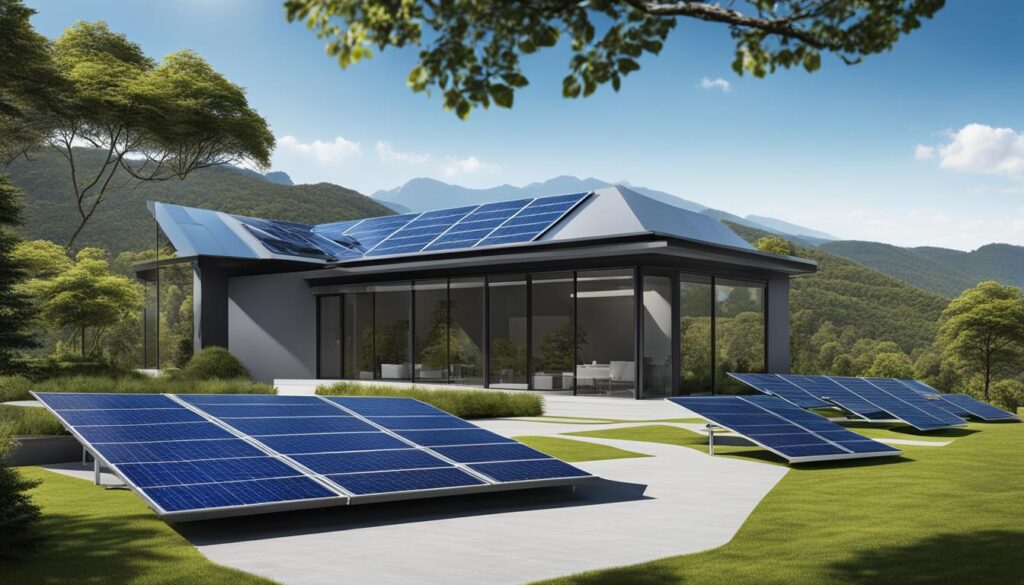Welcome to our latest article on N type solar panels, the high-efficiency solar panels that are revolutionizing the renewable energy industry. If you’re looking to boost your energy efficiency and maximize the utilization of solar resources, then N type solar panels are the top-rated choice for you. These cutting-edge solar panels utilize advanced solar cells to provide superior efficiency, making them a game-changer in the world of sustainable energy.
Key Takeaways:
- N type solar panels offer superior efficiency and performance.
- Phosphorus plays a crucial role in enhancing the efficiency of N type solar cells.
- N type solar panels have achieved record-breaking levels of efficiency in the industry.
- N type solar panels are a more innovative solar technology option compared to traditional P type solar panels.
- Adopting N type solar panels can have a significant impact on energy efficiency and cost savings.
Understanding N Type Solar Panels and Their Advantages
N type solar panels are a type of next-generation solar technology that offers superior performance compared to traditional solar panels. These innovative solar panels have revolutionized the solar industry, paving the way for more efficient and sustainable energy solutions.
The Role of Phosphorus in Enhancing Efficiency
One of the key factors contributing to the superior performance of N type solar panels is the use of phosphorus in the manufacturing process. Phosphorus has one more electron than silicon, resulting in negatively charged N-type solar cells. This additional charge improves the overall efficiency of the solar panel by increasing the flow of electrons, leading to a higher energy output.
By harnessing the unique properties of phosphorus, N type solar panels are able to generate more electricity from sunlight, maximizing the utilization of solar resources and increasing energy production.
Record-Breaking Efficiency Achievements with N Type
N type solar panels have made significant strides in achieving record-breaking levels of efficiency. Manufacturers like Trina have introduced innovative N-type i-TOPCon solar cells that have set new world records in terms of efficiency.

“The advancements in N type solar panel technology have enabled us to achieve unprecedented levels of efficiency, setting new standards in the industry. With an efficiency level of 25.5%, our N-type i-TOPCon solar cell represents a major breakthrough in solar energy production.” – Trina Solar Representative
These exceptional efficiency achievements highlight the potential of N type solar panels to significantly increase energy production, reduce reliance on fossil fuels, and pave the way for a more sustainable future.
Innovative Solar Technology: N Type vs P Type Solar Panels
N type solar panels vs P type solar panels:When comparing solar panel technologies, N type solar panels and P type solar panels are often seen as two main contenders. N type solar panels, with their superior efficiency and performance, offer a more innovative approach to solar technology compared to traditional P type solar panels.
The main difference between N type and P type solar panels lies in the type of semiconductor material used and the doping elements present in the cells. N type solar panels utilize N-type semiconductor material, typically made from high-purity silicon with phosphorus doping, whereas P type solar panels use P-type semiconductor material, which is doped with boron. This distinction in materials and doping processes results in different electrical properties and performance characteristics.
While P type solar panels have been dominant in the market for many years, the advancements and advantages of N type solar panels are making them a viable choice for those seeking cutting-edge solar technology. N type solar panels offer higher efficiency, better low-light performance, and superior temperature coefficients compared to P type solar panels. These advanced solar panels are particularly well-suited for applications that require maximum energy production and optimal performance, such as large-scale solar farms and commercial installations.
The Impact of N Type Solar Panels on Energy Efficiency
The adoption of N type solar panels can have a significant impact on energy efficiency in various aspects. These cutting-edge solar technology advances offer numerous benefits, including:
Maximizing Power Output in Variable Climates
N type solar panels excel in maximizing power output in variable climates, making them ideal for regions with fluctuating weather conditions and limited sunlight. Their high-performance solar modules are designed to adapt and generate energy efficiently, even in challenging environments. This capability ensures consistent power generation throughout the year, allowing for optimal utilization of solar resources.

Leveraging High-Performance Solar Modules for Cost Savings
One of the key advantages of N type solar panels is the ability to leverage their high-performance solar modules for cost savings. These modules, equipped with advanced solar cells, deliver superior efficiency, durability, and reliability. As a result, they can generate more energy with less reliance on external resources, leading to significant cost savings over the system’s lifetime. Moreover, the reduced maintenance requirements of advanced solar cells contribute to additional long-term cost savings.
Lowering Levelized Cost of Electricity with Advanced Solar Cells
Another compelling benefit of adopting N type solar panels is their potential to lower the levelized cost of electricity. The utilization of advanced solar cells in N type panels enhances their overall performance and efficiency, resulting in increased energy production. This increased energy output, combined with reduced maintenance costs and improved system reliability, contributes to a lower cost per unit of electricity generated. By enabling more affordable renewable energy solutions, N type solar panels play a crucial role in driving the adoption of sustainable energy sources and promoting a greener future.
| Advantages of N Type Solar Panels | Features |
|---|---|
| Maximizing power output | High-performance solar modules adapt to variable climates |
| Cost savings | Advanced solar cells ensure optimal performance and reduced maintenance costs |
| Lower levelized cost of electricity | Increased energy production and improved reliability lead to more affordable renewable energy solutions |
Conclusion
By harnessing the power of N type solar technology, we can take significant strides towards a sustainable future. These highly efficient and reliable N type solar panels provide a promising solution for transitioning to renewable energy sources and reducing our dependence on fossil fuels.
With their impressive efficiency achievements and numerous advantages, Top-rated N-type solar panels are poised to play a crucial role in shaping a greener future. The adoption of these advanced solar panels has the potential to drive the global energy landscape towards sustainability.
Bridging the Gap to a Sustainable Future with N Type Solar Technology
N type solar panels offer a sustainable solution by harnessing the limitless power of the sun. With their ability to generate clean energy, these panels contribute to reducing carbon emissions and combating climate change.
The Future Horizon of N Type Solar Panel Installations
Looking ahead, ongoing advancements and research in solar technology are set to further enhance the efficiency and performance of N type solar panels. As these improvements continue, we can expect N type solar panel installations to become an integral part of the energy revolution.
With a brighter future on the horizon, N type solar panels are paving the way towards a sustainable and greener world powered by renewable energy. Together, we can build a future where clean energy is accessible to all and our planet thrives.
FAQ
What are N type solar panels?
N type solar panels are a type of solar panel technology that offers superior efficiency, making them a top choice for boosting energy efficiency in various applications.
How do N type solar panels achieve high efficiency?
N type solar panels use N-type solar cells that utilize phosphorus in their manufacturing process, resulting in enhanced performance.
How efficient are N type solar panels?
N type solar panels have gained recognition for their record-breaking efficiency achievements in the industry, setting new standards for solar energy production. For example, Trina’s new N-type i-TOPCon solar cell set a new world record with an efficiency level of 25.5%.
How do N type solar panels compare to P type solar panels?
N type solar panels offer a more innovative approach to solar technology compared to traditional P type solar panels, with their superior efficiency and performance.
What advantages do N type solar panels offer?
Leveraging the advanced solar cells of N type solar panels can contribute to cost savings in the long run due to their superior efficiency, durability, and reliability. Additionally, they have the potential to lower the levelized cost of electricity, making renewable energy solutions more accessible and economically viable.
Can N type solar panels maximize power output in variable climates?
Yes, N type solar panels excel in maximizing power output in variable climates, making them ideal for regions with fluctuating weather conditions and limited sunlight.
How do N type solar panels impact energy efficiency?
The high-performance solar modules of N type solar panels allow for enhanced power generation, resulting in increased energy production and improved efficiency.
What is the future outlook for N type solar panel installations?
The future horizon of N type solar panel installations is bright, with ongoing advancements and research expected to further improve the efficiency and performance of these cutting-edge solar panels. This makes them an integral part of the global energy landscape.
How can N type solar panels contribute to a sustainable future?
The adoption of N type solar panels has the potential to drive the transition to renewable energy sources and reduce reliance on fossil fuels, bridging the gap to a sustainable future powered by renewable energy.

